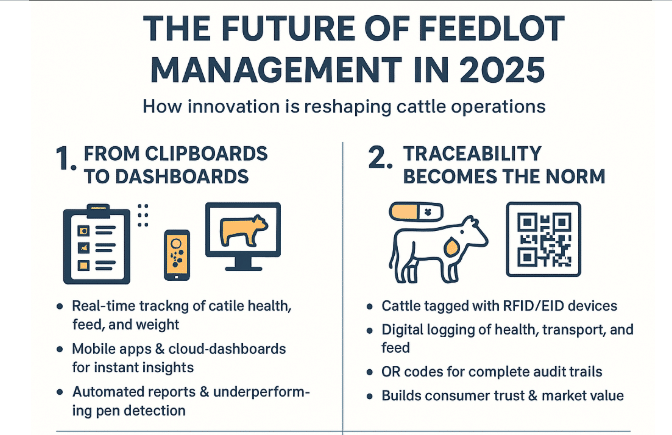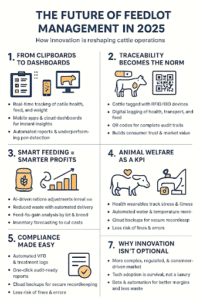The Future of Feedlot Management: Innovations Reshaping Cattle Operations in 2025

Feedlot management in 2025 is undergoing a major transformation. Rising input costs, volatile market conditions, stricter environmental regulations, and growing expectations around animal welfare are forcing cattle producers to adapt—or risk losing their competitive edge.
The difference today is that progressive producers aren’t just reacting. They’re reshaping how feedlots operate by adopting feedlot management software, investing in digital traceability, and leveraging data-driven decision-making to improve efficiency and sustainability.
In this article, we’ll explore what forward-thinking feedlot operators are doing differently in 2025, and why traditional methods of managing pens, rations, herd health, and compliance may no longer be enough.
-
From Clipboards to Dashboards: Digital Tools Take the Lead in Feedlot Management
Not long ago, feedlot managers relied on clipboards, notebooks, and spreadsheets to capture vital data. Information about cattle health, feed intake, or pen movements was often scattered, delayed, or lost. In 2025, this approach no longer works—efficiency and profitability demand something more advanced.
Modern operations now run on feedlot management software, giving producers real-time visibility into every stage of production. These platforms track:
- Cattle health and treatments (with alerts for re-checks)
- Daily weight gains and performance trends by pen, lot, or breed
- Feed consumption and inventory forecasting based on real usage
- Withdrawal periods and compliance logs
- Underperforming pens before losses affect margins
The biggest shift in 2025 is widespread adoption. Once accessible only to large-scale feedlots, digital tools have become affordable, mobile-ready, and user-friendly, opening the door for mid-sized and smaller operations to compete at scale.
With mobile apps and cloud-based dashboards, managers and workers can input data directly from the field and view actionable insights instantly. This eliminates manual paperwork, reduces errors, and ensures that critical decisions are made with up-to-date, accurate information.
What powers this change is the integration of automation and smart recordkeeping. Feedlot management systems now connect seamlessly with other livestock, feed, and inventory platforms—creating a unified ecosystem that helps producers cut waste, stay compliant, and optimize every aspect of feedlot performance.
In short, the clipboard era is over. The feedlot of 2025 runs on dashboards and digital intelligence that make operations leaner, smarter, and more profitable
2. Traceability Isn’t Just for Export Markets Anymore
Traceability used to be a concern mainly for producers supplying premium or export markets. That’s no longer the case.
Retailers, regulators, and even domestic consumers are increasingly asking: Where did this beef come from? Was it raised responsibly? Were antibiotics used appropriately? In 2025, that transparency is becoming the baseline, not the exception.
Modern feedlots are:
- Tagging cattle with EID or RFID devices on intake
- Logging origin, transport, health, and feed records digitally
- Integrating health data into traceability logs
- Using QR codes or scannable batch IDs to store audit trails
When this data is tied together in a unified system such as an ERP solution for the agriculture industry it becomes a powerful tool not just for compliance, but also for differentiation in the marketplace.
Being able to say “We can verify everything about this animal’s journey, from feedlot intake to harvest” adds value, builds trust, and protects the brand.
3. Smart Feeding = Leaner Costs and Better Gains
Feed is the biggest cost center in any feedlot and managing it well is where many producers are gaining an edge.
Progressive operations are now using software and smart equipment to:
- Analyze feed-to-gain ratios by lot, source, and breed
- Adjust rations in real-time based on performance trends
- Reduce feed waste using automated delivery logs
- Track feed inventory by ingredient and cost per head
Gone are the days when a nutritionist emailed out rations once a week and hoped for the best. Today’s tech-enabled feedlot managers are making adjustments on the fly using real-time data to test ration effectiveness, monitor consumption patterns, and forecast inventory depletion days.
AI-driven recommendations are also gaining traction, helping feed managers simulate what will happen if a certain pen gets switched from one ration mix to another based on historical outcomes.
4. Animal Welfare as a Measurable Performance Indicator
Animal welfare has always mattered to good producers. What’s changed is that it’s now measurable, visible, and tied to revenue.
Cattle performance improves when animals are less stressed, more comfortable, and treated early. In 2025, progressive feedlots are proving that investment in animal comfort and welfare translates to healthier animals and fewer losses.
Here’s how they’re doing it:
- Using wearable health monitoring devices for signs of fever, stress, or inactivity
- Digitally logging behavior changes for early illness detection
- Tying mortality and pull rates directly to management actions
- Improving pen design for airflow, space, and shade access
- Automating water intake and temperature tracking
With software flagging anomalies and showing performance patterns, managers are catching problems faster and spending less time reacting to disasters.
Some systems even automate alerts if a pen’s average feed intake drops unexpectedly helping staff respond to issues before they escalate.
5. Compliance Without the Headache
Ask any feedlot manager what keeps them up at night, and compliance is bound to come up.
Whether it’s Veterinary Feed Directives (VFD), environmental permitting, animal treatment logs, or traceability audits, the paperwork burden has become a serious operational strain.
Progressive producers are now automating compliance by:
- Setting digital VFD rules in the system
- Logging every treatment electronically, down to the animal
- Generating full reports for regulators, processors, or auditors in minutes
- Creating “pull lists” for re-treatment or withdrawal waiting periods
The result? Fewer errors, fewer fines, and fewer hours spent sorting through stacks of handwritten records. In many operations, digital logs are now synced with cloud backup, so nothing is lost even if devices break or staff turns over.
6. Empowering the Feedlot Workforce with Better Tools
Another reality facing feedlots in 2025? Labor is tight. Recruiting and retaining skilled pen riders, feed truck drivers, and yard managers is harder than ever.
But the best operators aren’t just throwing more people at the problem. They’re investing in technology that makes each worker more effective.
Here’s what that looks like:
- Staff use tablets or phones to log animal treatments directly in the pen
- Drivers get automated load sheets for the day’s feed deliveries
- Admins can generate batch reports or pull histories instantly
- New hires can be trained faster using video walkthroughs and in-app guidance
By reducing manual paperwork, duplication, and confusion, good software helps lean teams operate like large ones.
7. Why Feedlot Innovation Is No Longer Optional
The feedlot industry in 2025 is at a crossroads. The most successful operations share one common trait: they continuously evolve. Sticking with the same methods that worked a decade ago is no longer enough to survive in today’s environment.
Rising input costs, tighter regulations, growing consumer scrutiny, and shifting market demands have created a landscape where agility is everything. Feedlot managers can no longer rely on tradition or intuition alone—they must adopt systems and practices that are adaptable, scalable, and data-driven.
Innovation doesn’t mean chasing every new piece of technology. Instead, it means strategically investing in solutions that:
- Streamline compliance and reduce operational risk
- Provide accurate, real-time data to guide decision-making
- Improve efficiency in feeding, health management, and logistics
- Strengthen animal welfare outcomes, which now directly affect profitability
- Build transparency and traceability that retailers and consumers demand
For forward-thinking producers, innovation is not about “nice-to-have” extras—it’s about staying competitive and resilient in a sector that’s becoming more complex and consumer-driven every year.
In short: innovation is survival. Feedlots that embrace digital tools, automation, and smarter practices are positioning themselves for long-term growth, while those that resist change risk being left behind.
Final Thoughts: A Future Built on Better Systems
The feedlot of 2025 isn’t futuristic; it’s practical, lean, and smarter than ever before. It still runs on cattle, feed, and hard work. But it also runs on data, automation, and integrated systems that help every person, from pen rider to general manager, do their job better.
Progressive producers aren’t necessarily doing more, they’re doing less with better tools, focusing on what matters, and leveraging modern solutions to eliminate waste, improve welfare, and protect their margins.
For producers looking to stay competitive over the next five years, investing in tools like feedlot management software and a full-spectrum ERP solution for the agriculture industry isn’t just a luxury, it’s part of running a future-ready business.

What Makes a Key West Spearfishing Company Stand Out From the Competition

A Comprehensive Guide to Performance Marketing Platforms and Tools

Data Automation Tools for Modern Businesses

Accelerating drug discovery through the DEL-ML-CS approach

AI in Marketing Is No Longer a Buzzword — It’s the Strategy

The Future of Feedlot Management: Innovations Reshaping Cattle Operations in 2025

Is Singapore's 'Smart Nation' Initiative Making Renting Smarter, or Just More Expensive?

FSI Blogs US: Complete Guide, Insights, and Relevance









